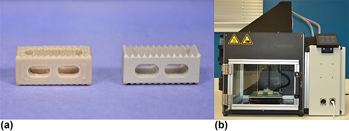Crossref Citations
This article has been cited by the following publications. This list is generated based on data provided by
Crossref.
Ma, Jing
Xue, Yizebang
Liang, Xinyu
Liao, Chengzhu
Tan, Zhijie
and
Tang, Bin
2019.
Bi-directional regulatable mechanical properties of 3D braided polyetheretherketone (PEEK).
Materials Science and Engineering: C,
Vol. 103,
Issue. ,
p.
109811.
Haleem, Abid
and
Javaid, Mohd
2019.
Polyether ether ketone (PEEK) and its manufacturing of customised 3D printed dentistry parts using additive manufacturing.
Clinical Epidemiology and Global Health,
Vol. 7,
Issue. 4,
p.
654.
Choi, Jeongho
and
Lee, Sang-ik
2019.
Experimental validation of theoretical models for hypercube models made by fused deposition modelling technology.
Journal of Mechanical Science and Technology,
Vol. 33,
Issue. 12,
p.
5951.
Wang, Jian
Huang, Ruiying
Chen, Haoxiang
Qiao, Xiaoyin
Shi, Xuelei
Wang, Xiaocheng
Cheng, Yanxiang
Tan, Weihong
and
Tan, Zhikai
2019.
Personalized Single‐Cell Encapsulation Using E‐Jet 3D Printing with AC‐Pulsed Modulation.
Macromolecular Materials and Engineering,
Vol. 304,
Issue. 4,
Sviridov, A
Lopatina, Iu
and
Kurganova, Iu
2019.
3D-printed polyether ether ketone samples mechanical properties estimation.
IOP Conference Series: Materials Science and Engineering,
Vol. 589,
Issue. 1,
p.
012021.
Haleem, Abid
and
Javaid, Mohd
2019.
Polyether ether ketone (PEEK) and its 3D printed implants applications in medical field: An overview.
Clinical Epidemiology and Global Health,
Vol. 7,
Issue. 4,
p.
571.
Zanjanijam, Ali Reza
Major, Ian
Lyons, John G.
Lafont, Ugo
and
Devine, Declan M.
2020.
Fused Filament Fabrication of PEEK: A Review of Process-Structure-Property Relationships.
Polymers,
Vol. 12,
Issue. 8,
p.
1665.
Choi, Jeongho
2020.
Truss and Frames - Recent Advances and New Perspectives.
Liao, Chengzhu
Li, Yuchao
and
Tjong, Sie Chin
2020.
Polyetheretherketone and Its Composites for Bone Replacement and Regeneration.
Polymers,
Vol. 12,
Issue. 12,
p.
2858.
Maguire, Alianna
Pottackal, Neethu
Saadi, M A S R
Rahman, Muhammad M
and
Ajayan, Pulickel M
2020.
Additive manufacturing of polymer-based structures by extrusion technologies.
Oxford Open Materials Science,
Vol. 1,
Issue. 1,
Elhattab, K.
Sikder, P.
Walker, J.M.
Bottino, M.C.
and
Bhaduri, S.B.
2020.
Fabrication and evaluation of 3-D printed PEEK scaffolds containing Macropores by design.
Materials Letters,
Vol. 263,
Issue. ,
p.
127227.
Lopatina, Y
and
Filippova, A
2020.
Research of composition porosity based on 3d-printed frames and impregnated with epoxy resin.
IOP Conference Series: Materials Science and Engineering,
Vol. 963,
Issue. 1,
p.
012031.
Choi, Jeongho
2020.
Proceedings of the 11th International Conference on Porous Metals and Metallic Foams (MetFoam 2019).
p.
59.
Basgul, Cemile
MacDonald, Daniel W.
Siskey, Ryan
and
Kurtz, Steven M.
2020.
Thermal localization improves the interlayer adhesion and structural integrity of 3D printed PEEK lumbar spinal cages.
Materialia,
Vol. 10,
Issue. ,
p.
100650.
Kulkarni, Arvind Gopalrao
Sagane, Shrikant S.
and
Kunder, Tushar Satish
2020.
Management of spondylolisthesis using MIS techniques: Recent advances.
Journal of Clinical Orthopaedics and Trauma,
Vol. 11,
Issue. 5,
p.
839.
Delaney, Lauren J.
Basgul, Cemile
MacDonald, Daniel W.
Fitzgerald, Keith
Hickok, Noreen J.
Kurtz, Steven M.
and
Forsberg, Flemming
2020.
Acoustic Parameters for Optimal Ultrasound-Triggered Release from Novel Spinal Hardware Devices.
Ultrasound in Medicine & Biology,
Vol. 46,
Issue. 2,
p.
350.
Kholgh Eshkalak, Saeideh
Rezvani Ghomi, Erfan
Dai, Yunqian
Choudhury, Deepak
and
Ramakrishna, Seeram
2020.
The role of three-dimensional printing in healthcare and medicine.
Materials & Design,
Vol. 194,
Issue. ,
p.
108940.
Spece, H.
Yu, T.
Law, A.W.
Marcolongo, M.
and
Kurtz, S.M.
2020.
3D printed porous PEEK created via fused filament fabrication for osteoconductive orthopaedic surfaces.
Journal of the Mechanical Behavior of Biomedical Materials,
Vol. 109,
Issue. ,
p.
103850.
Gao, Xinshuai
Wang, Honghua
Zhang, Xu
Gu, Xinming
Liu, Yuzhe
Zhou, Guangyuan
and
Luan, Shifang
2020.
Preparation of Amorphous Poly(aryl ether nitrile ketone) and Its Composites with Nano Hydroxyapatite for 3D Artificial Bone Printing.
ACS Applied Bio Materials,
Vol. 3,
Issue. 11,
p.
7930.
Vaes, Dries
and
Van Puyvelde, Peter
2021.
Semi-crystalline feedstock for filament-based 3D printing of polymers.
Progress in Polymer Science,
Vol. 118,
Issue. ,
p.
101411.





